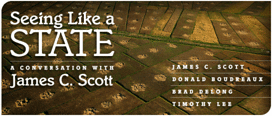Timothy Lee’s distinction between state-enforced standardization and spontaneously ordered standardization is crucial. And all that Lee says on this point (and in his earlier essay in this thread at Cato Unbound) has earned my sincere applause.
Anyone who blogs at Café Hayek, as I do, can hardly question the marvelous reach and power of spontaneous ordering forces!
And anyone who has been so deeply influenced, as I have been, by the works of James Buchanan and Gordon Tullock can scarcely doubt that politicians and their appointees will abuse whatever powers they might exercise to bring about standardization. Centrally imposed standards will be created and used – as Lee correctly points out – for the good of the state. Only by happenstance will the good of the state correspond to the good of society.
Pondering this question calls to my mind English common law. Celebrated by Hayek (among many others) as a chief reason why England and her progeny, such as the United States, have been open and free societies, the common law’s very name suggests standardization. Common law.
At one level, the common law might be said to be the product of the English crown: after 1066, English monarchs understood that their Norman blood would be less disagreeable to their subjects if these subjects were allowed to keep their local customs. As long as these customs kept the populace productive (and, hence, taxable) — and as long as these customs posed no serious threat to the security of the crown — the crown courts adopted into law many of the customs and norms that spontaneously arose from the everyday actions of ordinary folk going about their daily lives. That is, with relatively few exceptions, the law in England was not designed; it emerged decentrally and was discovered by judges.
Common themes were discovered by the courts and were given surer form and clearer identity as these were enunciated and enforced over the years. But these common themes — the substantive rules of the common law — were mostly not the creation of the state.
In this light, I have always found Hayek’s distinction between “law” and “legislation” to be very helpful. Law is a set of (seldom rigid) rules — or principles — that are discovered by the courts; legislation is a set of much more rigid rules that are created and imposed consciously by the sovereign, often to achieve ends that serve the sovereign’s interests at the expense of the general population. (To this day I wince whenever I hear legislators described as “lawmakers.” They are not.)
So, in fact, what was common about the common law wasn’t so much its specific content as it was the procedure for that law’s discovery and enforcement. A sovereign, headquartered in London, was sufficiently wise (or prudent) to standardize through England only the procedure for discovering and enforcing law. The resulting specific laws thus were more attuned to the expectations and practices of ordinary people throughout the realm, and also not part of any master plan to micromanage English society.
This rather standard (!) summary of the history of the common law necessarily omits countless details, nuances, and qualifications. And in light of James Scott’s lead essay I now suspect that the English crown was more active than I’d previously thought at imposing throughout England centrally designed standards for the purpose of improving the crown’s ability to tax or to otherwise control its subjects for its own narrow goals.
Still, the common law historically emerged from Norman conquerors’ self-interested wish to extract as much tax revenue over time as possible from the English people, yet one happy result of this particular form of standardization was a system of law-making that allowed for greater personal freedom and, eventually, unprecedentedly rapid and widespread economic growth.

